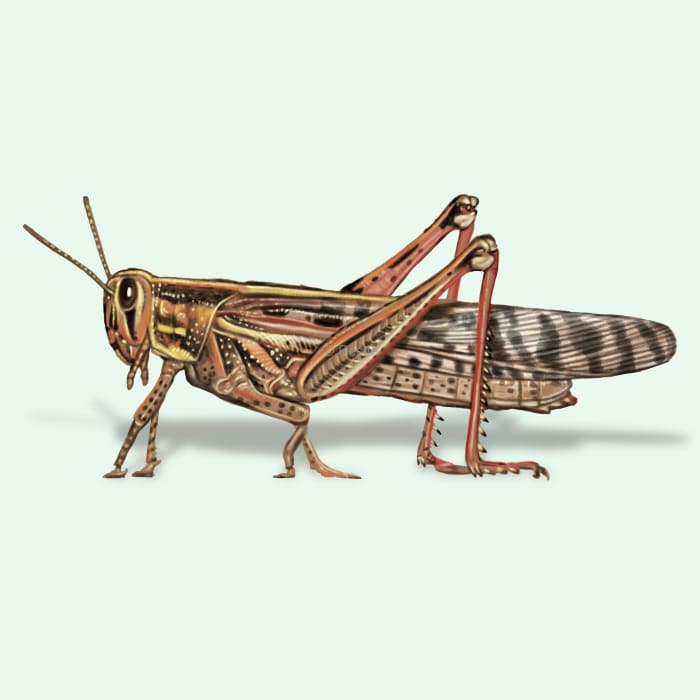How to identify and get rid of American bird grasshoppers

Grasshoppers in your garden? Time to jump into action!
Summer brings poolside lounging, vacations, and time spent out in the garden. However, it also brings plague-like insects to your yard!
Grasshoppers are often the source of frustration for many lawns and gardens.
But not just any grasshopper can invoke that kind of fear.
We’re talking about the American bird grasshopper, known for its impressive size and jumping ability. While these grasshoppers aren’t a threat to you directly, they can be quite the garden pest, feasting on your plants and vegetables.
The American bird grasshopper, also known as Schistocerca americana, thrives across the United States, particularly favoring open fields and grassy lawns, just like the ones in most suburban and rural gardens.
Their life cycle begins in the warm months when females lay clusters of eggs in the soil. These eggs then hatch into nymphs that look very similar to their parents but without the wings.
Each growth stage has an increasing appetite, leading to greater plant damage as the grasshoppers grow. Once they reach maturity, they begin changing colors and develop long wings. They are known to be strong flyers and can fly several hundred feet if disturbed.
How to identify American bird grasshoppers
The American bird grasshopper is one of the larger grasshopper species you might encounter in your yard. These grasshoppers are usually brown or green, which helps them blend into their surroundings, but they also sport distinctive yellow or orange markings that can give them away.
They have a white, creamy stripe that runs down from their head to the wings. Also, you can identify them by a black dot behind the side of their head that is split by a white line.
On their legs, you’ll notice a white dot on the “knees” of the grasshopper and their speckled wings.
How big are American bird grasshoppers?
Adults are about 1.5 to 2.5 inches long. They sometimes can be confused with a praying mantis because of their similar characteristics.
Where do American bird grasshoppers live?
American bird grasshoppers are found throughout the United States. They live in grassy areas and open fields.
How to get rid of American bird grasshoppers
Due to their ability to fly long distances and evade most control measures, keeping American bird grasshoppers away from your property can be a bit challenging.
However, you can do a few things to minimize the damage they do to your garden, lawn, or landscape plants.
- Habitat alteration: Reduce tall grassy areas where grasshoppers like to hang out.
- Row covers: Use floating row covers to protect plants in your garden.
- Predators: Encourage natural predators like birds or praying mantises that feed on grasshoppers.
- Handpicking: If you find nymphs early enough, you can handpick them off plants. Nymphs cannot fly and escape.
Check out Pestie’s pro-grade DIY solution that gives you a bug-free home without needing a pest control technician. You’ll get the same stuff the pros use but at a fraction of the price.
Treat american bird grasshoppers with Pestie
If you're still having trouble keeping american bird grasshoppers away, the best option is to use a pro-grade, effective pest control solution like Pestie.
Pestie is a do-it-yourself pest control solution that's specially designed to keep american bird grasshoppers and other pests away from your home.
With Pestie, you can rest easy knowing that your living space is protected and free of creepy crawlies. And the best part? It's designed for people, pets, and the planet, so you can say goodbye to harsh chemicals and hello to peace of mind!
- Save hundreds compared to traditional annual pest plans
- People, pet, and planet-friendly
- Pro-grade customized formulas
Quick facts
- Scientific name
Schistocerca Americana
- Other common names
American Grasshoppers
- Colors
Brown or green
- Life span
1 year
- Diet
Grasses, leaves, vegetable crops
How dangerous are American Bird Grasshoppers?
Low danger risk
American bird grasshoppers aren’t harmful to humans and don’t pose any health risks.
These grasshoppers can be found in many different colors. Temperatures influence the color of the nymphs. Lower temperatures produce redder colors, and higher temperatures result in more greens and yellows.








